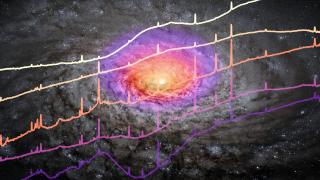Bibcode
Riffel, R. A.; Storchi-Bergmann, T.; Riffel, R.; Bianchin, M.; Zakamska, N. L.; Ruschel-Dutra, D.; Bentz, M. C.; Burtscher, L.; Crenshaw, D. M.; Dahmer-Hahn, L. G.; Dametto, N. Z.; Davies, R. I.; Diniz, M. R.; Fischer, T. C.; Harrison, C. M.; Mainieri, V.; Revalski, M.; Rodriguez-Ardila, A.; Rosario, D. J.; Schönell, A. J.
Referencia bibliográfica
Monthly Notices of the Royal Astronomical Society
Fecha de publicación:
5
2023
Número de citas
40
Número de citas referidas
34
Descripción
We present the hot molecular and warm ionized gas kinematics for 33 nearby (0.001 ≲ z ≲ 0.056) X-ray selected active galaxies using the H$_2\, 2.1218\, \mu$m and Br γ emission lines observed in the K band with the Gemini near-infrared integral field spectrograph. The observations cover the inner 0.04-2 kpc of each active galactic nucleus at spatial resolutions of 4-250 pc with a velocity resolution of σinst ≈ 20 ${\rm km\, s^{-1}}$. We find that 31 objects (94 per cent) present a kinematically disturbed region (KDR) seen in ionized gas, while such regions are observed in hot molecular gas for 25 galaxies (76 per cent). We interpret the KDR as being due to outflows with masses of 102-107 and 100-104 M⊙ for the ionized and hot molecular gas, respectively. The ranges of mass-outflow rates ($\dot{M}_{\rm out}$) and kinetic power ($\dot{E}_{\rm K}$) of the outflows are 10-3-101 M⊙ yr-1 and ~1037-1043 erg s-1 for the ionized gas outflows, and 10-5-10-2 M⊙ yr-1 and 1035-1039 erg s-1 for the hot molecular gas outflows. The median coupling efficiency in our sample is $\dot{E}_{\mathrm{K}}/L_{\rm bol}\approx 1.8\times 10^{-3}$ and the estimated momentum fluxes of the outflows suggest they are produced by radiation-pressure in low-density environment, with possible contribution from shocks.
Proyectos relacionados

Actividad Nuclear en Galaxias: una Perspectiva 3D del Núcleo y su Entorno
Nuestro proyecto puede dividirse en dos líneas principales de investigación. En primer lugar, el estudio de los vientos producidos por cuásares luminosos oscurecidos y del impacto que estos tienen en sus galaxias anfitrionas (retroalimentación del AGN). Para ello hemos obtenido observaciones en el óptico e infrarrojo cercano con el Gran Telescopio
Cristina
Ramos Almeida